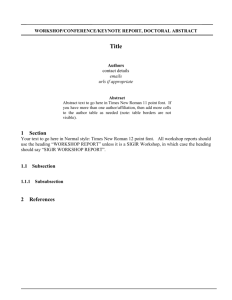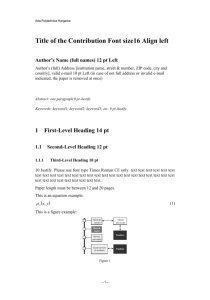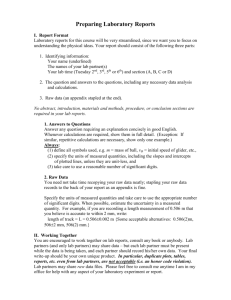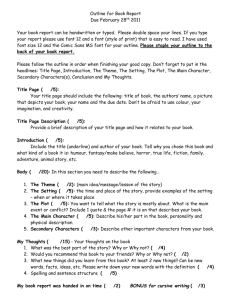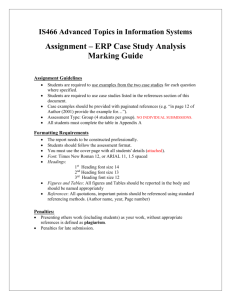EE431 Lab 0 An example of a reasonable informal lab report
advertisement
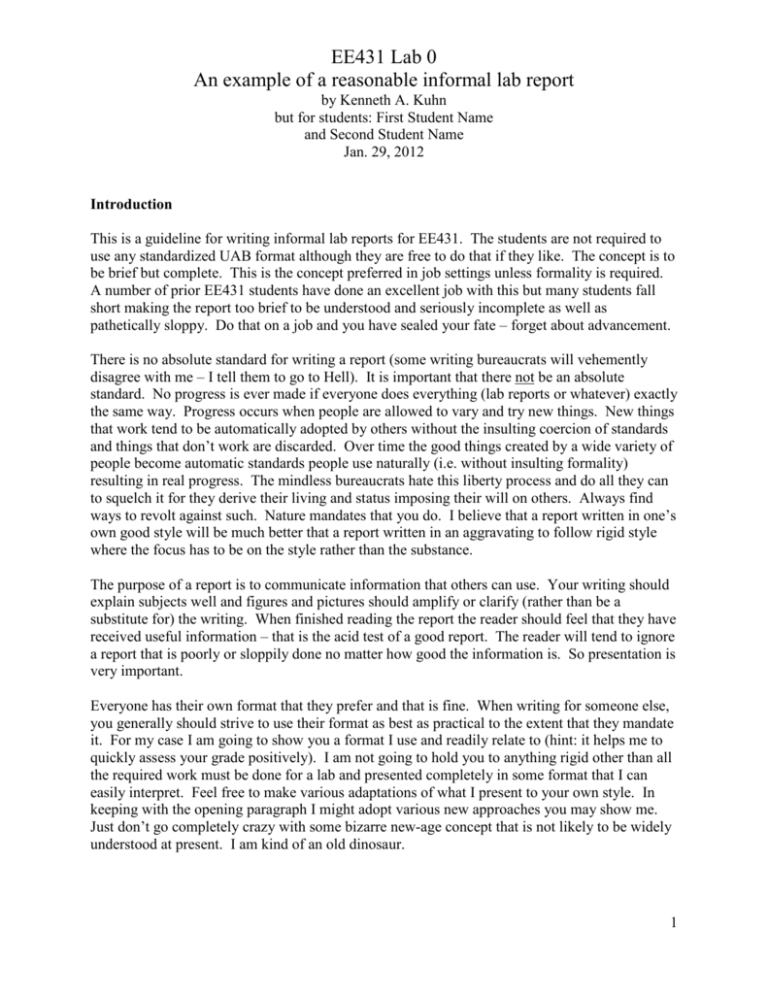
EE431 Lab 0 An example of a reasonable informal lab report by Kenneth A. Kuhn but for students: First Student Name and Second Student Name Jan. 29, 2012 Introduction This is a guideline for writing informal lab reports for EE431. The students are not required to use any standardized UAB format although they are free to do that if they like. The concept is to be brief but complete. This is the concept preferred in job settings unless formality is required. A number of prior EE431 students have done an excellent job with this but many students fall short making the report too brief to be understood and seriously incomplete as well as pathetically sloppy. Do that on a job and you have sealed your fate – forget about advancement. There is no absolute standard for writing a report (some writing bureaucrats will vehemently disagree with me – I tell them to go to Hell). It is important that there not be an absolute standard. No progress is ever made if everyone does everything (lab reports or whatever) exactly the same way. Progress occurs when people are allowed to vary and try new things. New things that work tend to be automatically adopted by others without the insulting coercion of standards and things that don’t work are discarded. Over time the good things created by a wide variety of people become automatic standards people use naturally (i.e. without insulting formality) resulting in real progress. The mindless bureaucrats hate this liberty process and do all they can to squelch it for they derive their living and status imposing their will on others. Always find ways to revolt against such. Nature mandates that you do. I believe that a report written in one’s own good style will be much better that a report written in an aggravating to follow rigid style where the focus has to be on the style rather than the substance. The purpose of a report is to communicate information that others can use. Your writing should explain subjects well and figures and pictures should amplify or clarify (rather than be a substitute for) the writing. When finished reading the report the reader should feel that they have received useful information – that is the acid test of a good report. The reader will tend to ignore a report that is poorly or sloppily done no matter how good the information is. So presentation is very important. Everyone has their own format that they prefer and that is fine. When writing for someone else, you generally should strive to use their format as best as practical to the extent that they mandate it. For my case I am going to show you a format I use and readily relate to (hint: it helps me to quickly assess your grade positively). I am not going to hold you to anything rigid other than all the required work must be done for a lab and presented completely in some format that I can easily interpret. Feel free to make various adaptations of what I present to your own style. In keeping with the opening paragraph I might adopt various new approaches you may show me. Just don’t go completely crazy with some bizarre new-age concept that is not likely to be widely understood at present. I am kind of an old dinosaur. 1 EE431 Lab 0 An example of a reasonable informal lab report My opinion is that unless a paper requires a title page that it is only extra work for nothing and wastes paper in this day when we strive to be green. I prefer no title page – but if you want to use one that is fine. The opening of your report should be exactly like the top of this page with the student and a possible lab partner listed on separate lines so I can easily spot the names. In the heading space the lab number should be on the top line (so I can find it easily among stacks of reports) and the title on the second line. It is always customary to show a date and these should be centered. I like a two-line space between the date and the heading, Introduction. But if you like single space then that is fine. The font used here is New Times Roman. Feel free to use any reasonable font that would have broad acceptance – the key attribute is that it is easy to read particularly for older people with failing vision – too cute fonts should be avoided in professional writing except possibly briefly for some point where standard fonts just won’t have the right impact. I often use font size 16 for the heading at the top of every page. Other people claim that size 14 is right. Size 18 is definitely too big and size 12 is too small. Use what you feel is best. I often use bold but sometimes that might be too gaudy. Use what you believe makes the best appearance. The font size for the body of the report should be around 11 or 12. Size 10 is too small and much bigger than 12 looks very amateurish. Line spacing generally should be single like what is used here. But some people prefer an additional space of ¼ or ½ line and that can help readability. A full line space is a bit much but about all that was practical in the past. Modern computer printing provides more options. Use what works best for you. Headings (example: Introduction and Your Introduction below) should be in bold. In short reports without many headings and sub headings it is common for the font size to be the same as used in the report text but a slightly larger size/style as provided in the newer word processors is fine and can help separate sections. Be consistent with the size/style throughout the report. When starting a new section I prefer a double space between the previous text and the heading as shown below although some writing bureaucrats say I am wrong – but I am showing it anyway to revolt. I also like a one line space between the heading and the text as shown below. I do not require any footings such as UAB, etc. although you are free to include whatever footing is your standard. Pages should be numbered – I use the lower right corner but feel free to alter that as needed. Your Introduction Note: I added the word, Your, to this heading to make it different from my introduction. Obviously, you will just have Introduction like I first used. There should be a one or two brief paragraph that provides an overview of what the type of lab measurements and results are required. It should be worded such that anyone can understand what is going on without having to refer to the lab assignment. Success here illustrates the ability to communicate – a requirement for being a good engineer. 2 EE431 Lab 0 An example of a reasonable informal lab report Heading for the first part of your experiment Your opening sentence for each section might be something such as – For this part of the experiment the circuit in Figure 0 was constructed and measurements were made to compute the suchnsuch characteristics of the thingamajig. Exactly what you say will obviously depend on the specific task being done but the opening sentence should be very clear and definite of what is going to be done. Some situations may not be practical to describe in a single sentence so use multiples as needed – the key point being communication. The next few sentences (and there will probably only be a few) will describe or point out specific important details. A figure of the circuit should be shown with a figure number and title. On the main /students page of the web site there are a set of Visio electronic schematic symbols designed to make good figures. I use these for all of my work. Some students use a scan of the schematic or figure supplied in the lab assignment. That is fine provided the scan is of sufficient quality to be presentable – I have seen some horrible and very crooked scans over the years. If you use a scan it is customary to put a short note (perhaps in 9 or 10 point font) immediately below the figure title line to the effect that the figure is a scan of a figure in the lab assignment. Always give credit where credit is due. If the number of measurements to be made is small then it is probably best to just include those in a couple of sentences such as – The voltage at base of the transistor was measured to be 5.67 volts and the collector voltage was measured to be 12.34 volts. Always include the correct units – I see many reports with missing or the wrong units. If there are a lot of measurements to make then a table format is probably better. Some calculations are probably required for your measurements so you can write something to the effect – The measured base and collector voltages were substituted into Equation 1 (be sure to show the symbolic equation) to compute the zingy function. You do not need to (and generally shouldn’t) show every gory step of the calculation – just make it clear what data went into the calculation to obtain the specific numerical result rounded to the appropriate number of significant digits (at least two, commonly three or four, never more than four unless you really have the measurement precision to justify that – people will rightfully laugh at you). If there are a lot of calculations on a lot of measured data then you might list the data and the corresponding calculations in a spreadsheet with an image of the appropriate cells pasted into the report. In all cases you would describe one example calculation as above for clarity in presentation. Never present calculated results without some discussion of the process and the equations used. At the end of the calculations there should be some discussion as to how the results agree with various reality checks, etc. Be sure to state specific numbers you are comparing. You might say – The zingy function computed from measurements was 6.54 volts. The theoretical calculation for the zingy function using the experiment settings is 6.78 volts. The close agreement is interpreted to mean that the experiment worked correctly. The last sentence here is rather difficult – your calculations will never precisely agree with theory for a variety of reasons. But, if things are going well then your results should be reasonably close. If your result had been 9.87 then you either need to figure out what you did wrong and repeat that part of the experiment or if 3 EE431 Lab 0 An example of a reasonable informal lab report you keep obtaining off results then state that the experiment was repeated n times with these results and it is not known why there is such a difference. It helps to include extra data concerning reality checks that do seem to work. Do the experiment well in advance of when it is due so that you can email me with questions about why something is not working. Include as much detail as you can so I can determine what you are doing wrong. Never, never, never, falsify results to agree with what you think it should. Always report what actually happened even if you know it is the wrong result – always include explanation as to why you think it is wrong. When odd results are obtained it is important to report all details about the experiment such as instrument settings, reality checks of instrument measurements to known things, etc. Such details (either for this class or on a job) may enable a more knowledgeable person to see what happened – that is to your credit. Students have successfully done this in the past and I was able to determine what went wrong – often a remarkably simple thing that the student did not know to consider or was important. I then know the student really did the work and they probably lose no points for an undesirable result. Falsifying results will get you in big trouble – no one will believe anything you do – you are then useless – so there is no point in you being employed. Generally do not compute percent error unless that is required and you know the correct way to compute the error – it is not always simple and you might make a fool of yourself in showing a percent error for logarithmic function as you will have later in the course. For some experiments you will need to include a plot. Use Excel and only the xy-scatter plotting function. Refer to example plots in my notes for how you should present the data. I always do charts on a separate Excel sheet and then copy the plot (as a picture) and then paste (as a picture) the plot into the Word document. You generally do not want to insert an Excel object as that can cause some weird and aggravating issues if it is not needed. The plots in my notes are generally of calculated data and do not include data point markers. In your case you should include data point markers. You can use a smoothed curve if that does not introduce weird wriggles in the plot – people will laugh at you if your plot shows non-reality. Otherwise, use straight line segments. Generally use a log axis if the data covers more than two decades. Over the years students have had a lot of difficulties doing plots – the most common one being to use the wrong type of plot (never, never, never use any plot structure other than xy-scatter unless that structure is really appropriate for the data – I will take points off if you do) resulting in weird non-linear axis and meaningless plots. You are free to use other plotting programs provided they produce the right results. Most students have easy access to Excel so that is why I reference that. Heading for the next part of your experiment Repeat the above for each part of the experiment. This is a good place to make another point about not so good lab reports in the past – please don’t copy words / paragraphs from the lab assignment and present them as yours. I want to see what you can write, not what I wrote. 4 EE431 Lab 0 An example of a reasonable informal lab report Conclusion It has always been standard practice to include a conclusion paragraph. If this helps to clarify the presentation then include it. For some labs this may be a waste of effort and about all you can say is something silly and obvious. You be the judge as to whether a conclusion is appropriate. Design details For some labs you have to design a circuit. Always discuss the design and the reasoning behind each decision/choice. Show all design equations. You do not need to show every gory computational step but you should show enough details so that someone else could replicate your calculations. That is very important in engineering – that someone else can check your work. Failure to include design details will definitely cost you in points. There is some debate as to whether design calculations should be typed or be hand notes in an appendix. Generally, I think they should be typed as you can include helpful explanations, etc. But hand notes may be better for some people (particularly if you have a good print style) and for some situations so I will let you be the judge. If you chose hand notes in an appendix then do not include the originals – use a scan instead that is inserted into and becomes part of the document with headings at the top of the page and page number/footings at the bottom. Grading The key thing that determines your grade is completeness in doing the experiment and presenting all that is required. I am not grading specifically on format. However, if your report strikes me as pathetic (I can’t follow it; it is sloppy; it has lots of grammatical errors; etc.) then you will lose points – perhaps a lot of points even if it is otherwise complete. You do not need to dazzle me with a highly professional work – although feel free to do that – it is refreshing to know that some students can. Dazzle will not gain you points for incompleteness. Cheating Every year I have excellent students who do all the real work and write original lab reports even if not perfect so the following does not apply to them. Copying lab reports from the present year or past years has been a serious problem in EE431 for a long time. I fight back by making the tests count for the majority of your grade. Some students think the labs should count more and they are right – for the good students – but then the cheating factor benefits the bad students. Some students (if that is what they should be called) must think I am an absolute idiot not to notice that eight lab reports have the identical data, the identical (and often wrong) plots, etc. In theory I could assign an ‘F’ to all essentially identical labs but I have not so far as the tests end up sorting out reality. I have had students who failed the course (but otherwise had OK lab grades) argue that they don’t understand why they failed because “They done real good in lab” as if I am too naïve to know the truth. 5 EE431 Lab 0 An example of a reasonable informal lab report I could also start academic misconduct proceedings. But I don’t because I know how the overall system is rigged so that a variety of people can slip through and obtain a degree with not a clue as to how to do engineering. There are even jobs at certain government and quasi government levels reserved for them (I am not supposed to know that but I have connections and exposure to a lot of things and can’t avoid knowing various secrets). They never actually do engineering on a job – they can’t. But they will enjoy the benefits of the title provided they can do certain minimum things and stay out of trouble – they sometimes mess up and lose a gravy job thus creating an opening for someone else. However, the number of such positions is limited so there are always many more applicants than positions available. Those that do not obtain these jobs will have no choice but to drop out of the concept of ever obtaining any engineering job as they are otherwise not hirable. These people are sometimes known as the failures of a school as if it is the fault of the school. The bottom line is if you cheat on lab there is not much I can do about it as labs are out of my direct control. But I can rig the tests (under my full control) to be such that you will likely lose a lot of points if you have not actually done the lab. I have seen cases where a student turned in a perfect lab but showed no clue at all on the test – interesting. So in the end you only cheat yourself. I have been in this business for around forty years so there is no way you are going to fool me. Seeing all the cheating makes the grading process particularly unpleasant as I am quite frustrated. It is refreshing to see the good papers where it is clear the students applied themselves. I am much more impressed with a student who perhaps only earns a D on a lab that they actually did than a student who copied something and made a B or better. Such a student is helpable. It is a waste of time to help a cheating student. Don’t think that I don’t know who cheats – I just can’t prove it so initially you get away with it. But I have the last say concerning the tests and I win! 6
